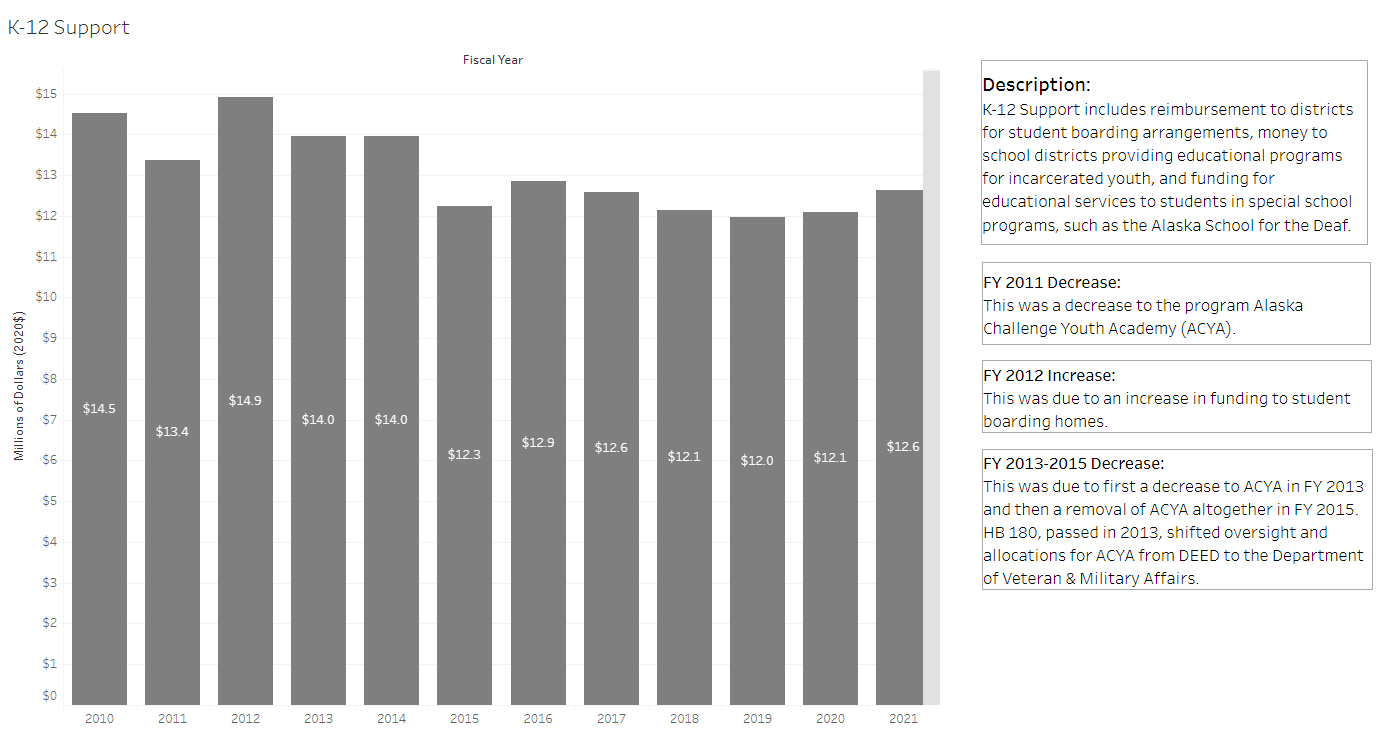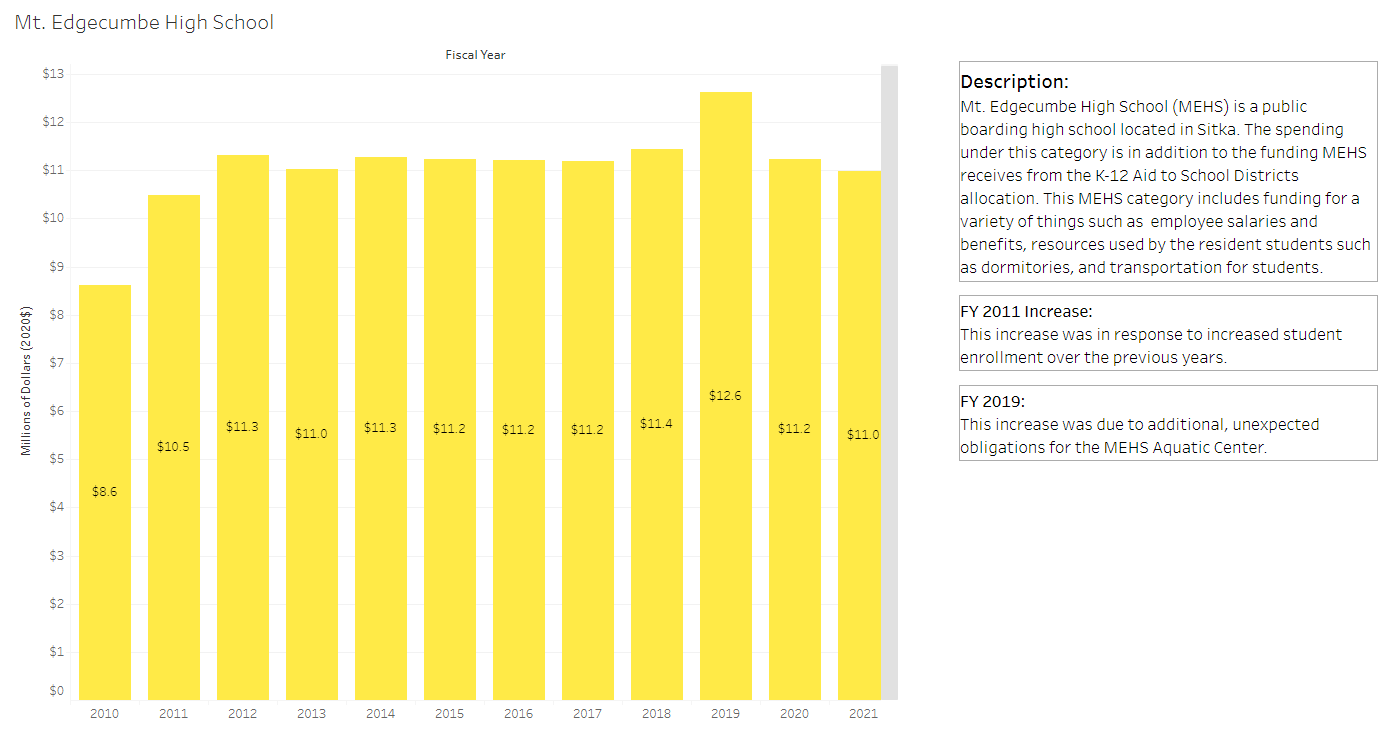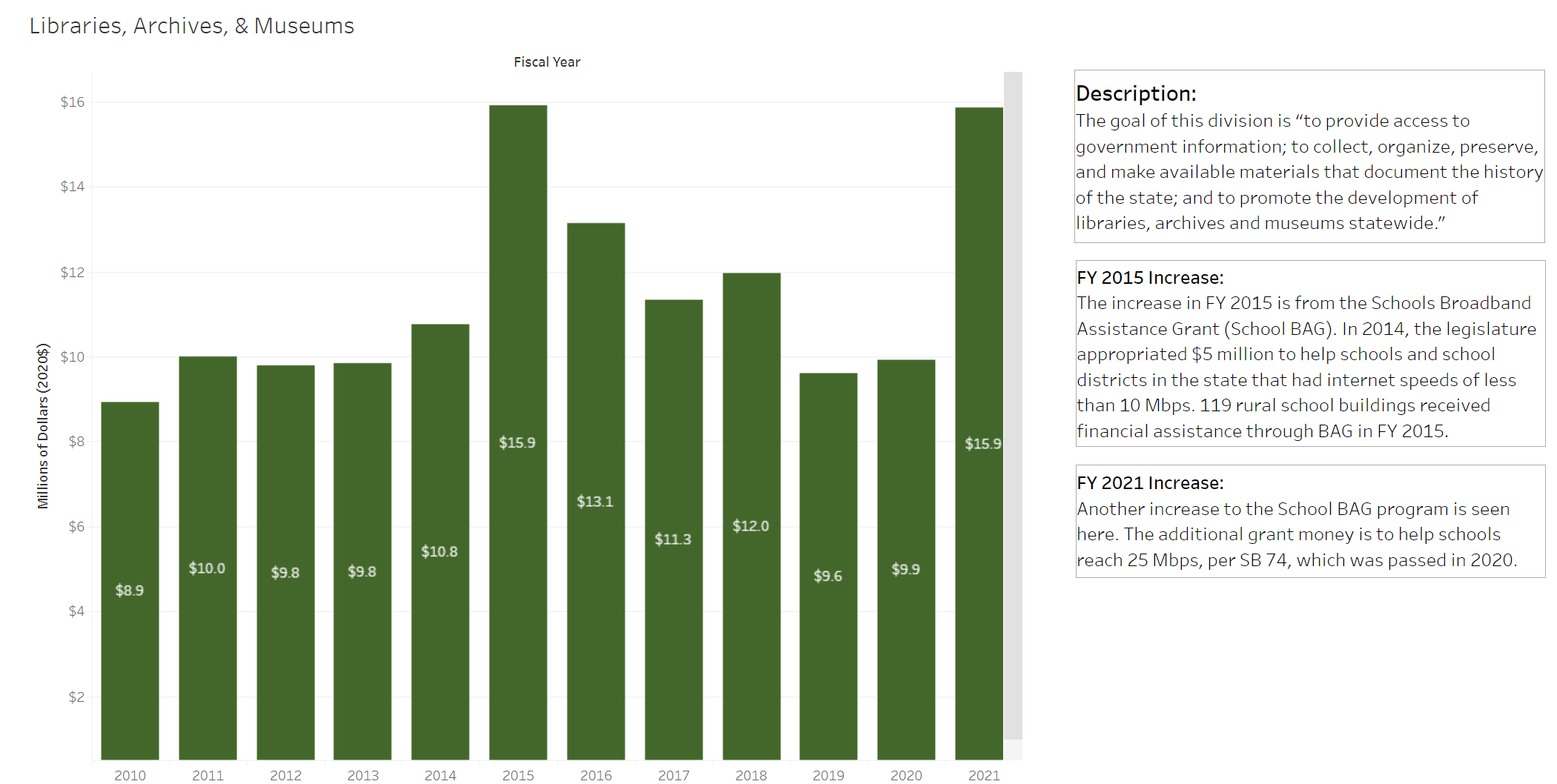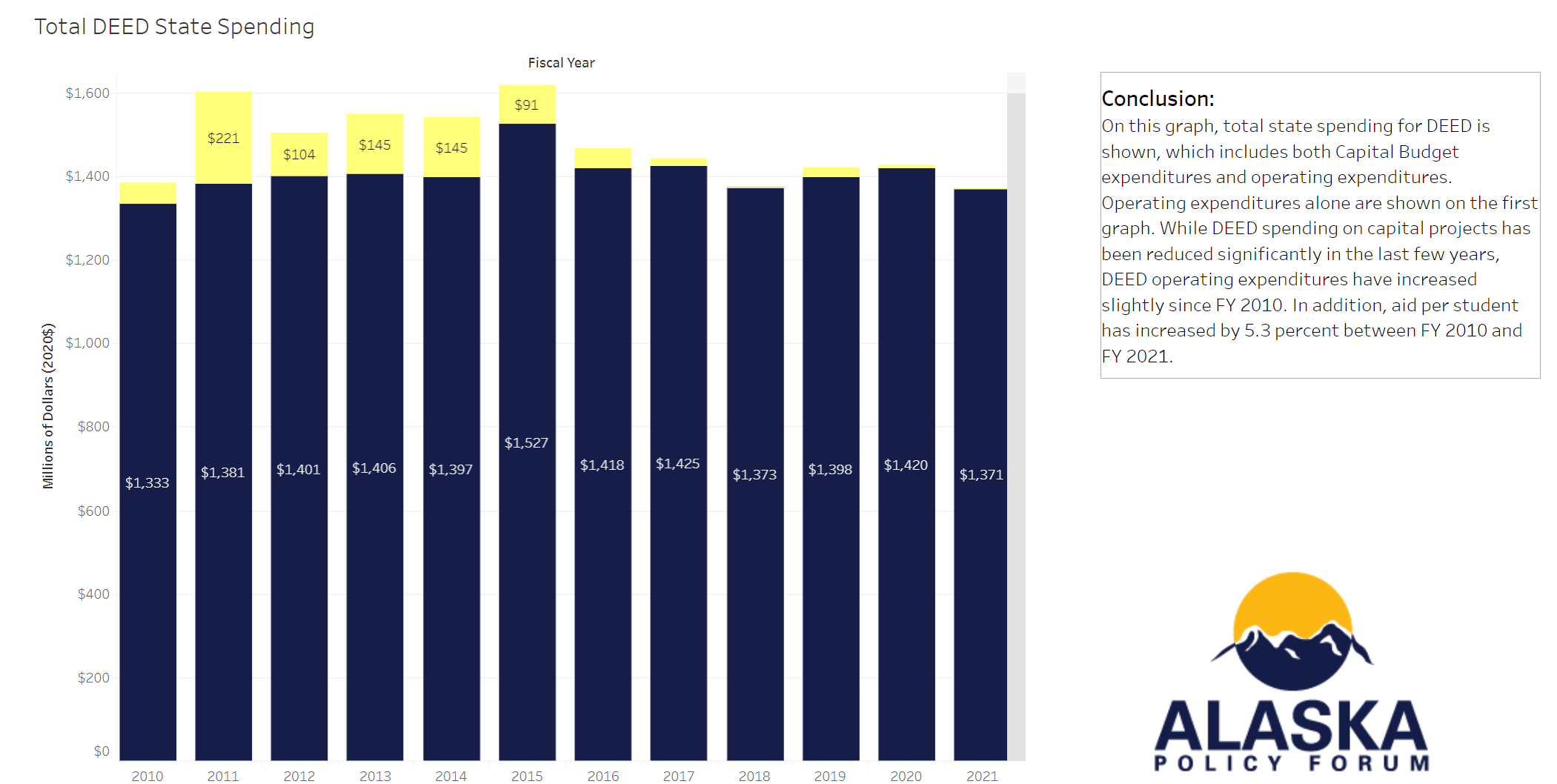Click here to view the interactive graphs (detached from the full report)
For many years, the Department of Education and Early Development (DEED) has required the largest portions of state spending, with the Department of Health and Social Services coming in at a close second. In this project, Alaska Policy Forum (APF) examines what DEED dollars are spent on and how the spending has changed between Fiscal Year 2010 (FY 2010) and FY 2021.
Budget Basics
For this report, we examine total DEED state spending, which includes operating expenditures (state spending from the Operating Budget), supplemental spending, and DEED spending from the Capital Budget (capital expenditures). For the purpose of this report, state spending excludes federal receipts, the Permanent Fund Dividend (PFD), and fund transfers. For further information on the differences between total state spending and the budget, please refer to “Debunking the Myth of Alaska’s ‘40% Budget Cuts.’”
Due to recording differences, DEED total state spending was not reported in the Legislative Finance Division (LFD) Allocation Totals in FY 2014 or FY 2015. Instead, the enacted budget amount was provided, which means that supplemental spending is not included for those two years. Keep this in mind as you compare across years – FY 2014 and FY 2015 total spending is likely more than is represented in this report. DEED capital spending, separated by funds, can also be found on the LFD website.
DEED State Spending
This graph shows operating expenditures between FY 2010 and 2021 by departmental division, as each division has a different goal or “category” within DEED. The final graph will show total DEED state spending, which includes capital expenditures. The purpose of separating DEED spending by divisions is to help conceptualize the types of things Alaska spends money on.
A state department’s budget is broken down into a variety of subcategories called appropriations and allocations. An appropriation is a group of programs or activities that has a similar goal. Appropriations usually correspond to a division within the department. For example, one DEED appropriation is Alaska State Libraries, Archives, and Museums, which encompasses the Libraries, Archives, and Museums division. Appropriations are made up of smaller allocations, which correspond to programs within a division. For example, there are several allocations for the Libraries, Archives, and Museums division, one being the Online with Libraries program (OWL). Each of the divisions in this report is made up of related allocations. Additionally, allocations (programs) may have multiple line items for expenditure categories such as staffing costs, travel for employees, the service the program is providing (such as IT training for libraries to do videoconferencing, a service provided by OWL), employee office equipment, contractual services by third parties, or grants to outside organizations or individuals. Often, new allocations are submitted in the governor’s budget by the departments and then codified when the budget bill passes the legislature, and the governor signs it into law. Other times, the legislature may pass a bill that requires a new allocation.
Each division provides programs (allocations) based on its mission and description of main services, as found in the corresponding budget book prepared by the Office of Management and Budget. The categories (divisions) are a way to help show where changes in spending have occurred, while also conceptualizing what kinds of programs are being funded.
DEED State Spending w/o Aid to School Districts
This graph is DEED’s operating expenditures without K-12 Aid to School Districts included. It shows the proportions of DEED state spending on the other divisions, without K-12 Aid to School Districts to distort the graph.
K-12 Aid to School Districts
K-12 aid to school districts is money that goes straight to the school districts and Mt. Edgecumbe High School for them to use at their discretion and includes pupil transportation.
The increase in FY 2015 was due to one-time additional state funding to the districts that was requested by Alaska’s governor in 2014 and codified by the legislature.
Education Support and Administrative Services
This division funds administrative services for DEED and educational support services, such as child nutrition programs, teacher certifications, and pre-K grants to schools.
The steady increase between FY 2010 and FY 2013 is due to increased funding every year for “Student and School Achievement,” which is the program that sets academic standards for students, facilitates statewide testing, and helps districts implement programs for struggling students.
The FY 2016 decrease was due to a cut in the “Student and School Achievement” program. HB 44 in 2015 repealed a requirement and associated funding for secondary students to take college and career readiness tests, such as the ACT, SAT, or WorkKeys.
In FY 2017, DEED no longer received funding for the Alaska Native Science and Engineering Program and the State Mentoring Program. Both programs still exist today but are now funded by the University of Alaska’s budget.
In FY 2019 there was a $6 million pre-kindergarten grant via legislation (SB 142, enacted in 2018) that provided funding to nine school districts for pre-K programs, which is why there is an increase in FY 2019.
Alaska Commission on Postsecondary Education
The Alaska Commission on Postsecondary Education (ACPE) includes programs that try to promote access to and success in education and training programs after high school. It also includes a program that provides residency training for medical school graduates.
SB 221, enacted in 2010, authorized the Alaska Performance Scholarship Awards. FY 2012 was the first year the state funded and distributed the scholarship awards to Alaskan students, which is why we see an increase in FY 2012.
The FY 2015 increase is due mainly to an increase in funding to the Alaska Education Grant (AEG). Funding was increased to comply with state statute, which requires that one-third of each year’s appropriation for both grants and scholarships be allocated to grants. The AEG funding had to be increased because of the previous years’ increase in funding for the Alaska Performance Scholarship Awards. The AEG is Alaska’s state need-based grant for residents enrolled at participating postsecondary education institutions in Alaska.
The decrease in FY 2016 is a result of moving the Alaska Student Loan Corporation (ASLC) from ACPE to its own component for transparency purposes. This structural change was done to comply with AS 14.42.190. After FY 2016, DEED transferred some ASLC funding back to ACPE for program administration and operations.
K-12 Support
K-12 Support includes reimbursement to districts for student boarding arrangements, money to school districts providing educational programs for incarcerated youth, and funding for educational services to students in special school programs, such as the Alaska School for the Deaf.
In FY 2011, there was a decrease to the program Alaska Challenge Youth Academy (ACYA). The FY 2012 increase, on the other hand, was due to an increase in funding to student boarding homes.
This was due to first a decrease to ACYA in FY 2013 and then a removal of ACYA altogether in FY 2015. HB 180, passed in 2013, shifted oversight and allocations for ACYA from DEED to the Department of Veteran & Military Affairs.
State Facilities Maintenance
This category funds maintenance for state-owned education buildings, such as Mt. Edgecumbe High School, and provides support for leased spaces.
One-time funding was allocated to cover the maintenance and operations (M&O) costs for the new State Libraries, Archives and Museums facility (SLAM) for the last three months (April, May, June 2016) of FY 2016. In those three months, the state had to pay for both the M&O costs of SLAM as well as the lease payments of the buildings the division was in before the completion of SLAM. The construction of the SLAM facility was included in the 2014 Capital Budget, SB 119.
Before 2019, the maintenance for the Andrew P. Kashevaroff (APK) building was funded through both the State Facilities Maintenance component and the Library Operations component of the DEED budget. Beginning in FY 2019, DEED chose to transfer the APK building maintenance to its own component, which is shown under State Facilities Maintenance in this report. The increase here is the transfer of the funding that was previously under the Library Operations component, represented in the Library, Archives, and Museums graph.
The FY 2021 increase is due to the legislature transferring maintenance of the Mt. Edgecumbe High School Aquatic Center from the Department of Transportation and Public Facilities to DEED.
Mt. Edgecumbe High School
Mt. Edgecumbe High School (MEHS) is a public boarding high school located in Sitka. The spending under this category is in addition to the funding MEHS receives from the K-12 Aid to School Districts allocation. This MEHS category includes funding for a variety of things such as employee salaries and benefits, resources used by the resident students such as dormitories, and transportation for students.
The FY 2011 increase was in response to increased student enrollment over the past few years. The FY 2019 increase, on the other hand, was due to additional, unexpected obligations for the MEHS Aquatic Center.
Libraries, Archives, and Museums
The goal of the Libraries, Archives, and Museums division is “to provide access to government information; to collect, organize, preserve, and make available materials that document the history of the state; and to promote the development of libraries, archives and museums statewide.”
The increase in FY 2015 is from the Schools Broadband Assistance Grant (School BAG). In 2014, the legislature appropriated $5 million to help schools and school districts in the state that had internet speeds of less than 10 Mbps. 119 rural school buildings received financial assistance through BAG in FY 2015.
Another increase to the School BAG program occurred in FY 2021. The additional grant money is to help schools reach 25 Mbps, per SB 74, which was passed in 2020.
Commissions and Boards
Commissions and Boards includes two programs: the Professional Teaching Practices Commission (PTPC) and the Alaska State Council on the Arts (ASCA). PTPC helps train educators in the state and also promotes adherence to a Code of Ethics. The ASCA funds individuals and organizations in Alaska that are involved in art projects.
Between FY 2017 and FY 2021, the ASCA received two increments of state funding, totaling $1.9 million. The funds are for outgoing grants to individuals, businesses, and non-profit organizations in Alaska, and personnel costs, travel, and services for ASCA program administration. The PTPC, on the other hand, had a slight decrease in funding over those same years.
Alaska Student Loan Commission (ASLC)
The ASLC provides loans to individuals enrolled in postsecondary schools in Alaska. In FY 2016, ASLC was moved from ACPE to its own component, due to structural modification to comply with AS 14.42.190.
Aid per Student
This graph shows aid per student, which was calculated by dividing K-12 Aid to School Districts by the four to 18-year-old population in each year. The most recent population estimates are for 2020. Because some school districts offer state-funded pre-kindergarten programs, four-year-olds were included in the school-age population number. As seen on the graph, aid per student has increased since FY 2010.
While additional programs could most likely be included in this calculation to estimate how much money is being spent to support Alaska’s children, K-12 Aid to School Districts is the most clear-cut category. As a reminder, school districts are able to spend the funding from this category at their discretion.
Conclusion
As seen in this graph, DEED spending on capital projects has been reduced significantly the last few years, but DEED operating expenditures have increased slightly since FY 2010. More notably, aid per student has increased 5.3 percent between FY 2010 and FY 2020.
Some key takeaways from this analysis:
- The vast majority of DEED state spending is for K-12 Aid to School Districts, which is largely a “black hole,” as districts are able to spend that money at their discretion, with little reporting.
- Aid per student has increased 5.3 percent over the last decade.
- State spending is not as transparent as it should be – the Allocation Totals report from LFD changed formats in FY 2014 and FY 2015, making it difficult to find total DEED spending by allocation for those years. Additionally, while reporting is easier to read than on DHSS reports, some details of spending changes were not made apparent in documentation available for the public, such as the LFD reports and the OMB budget books.
Overall, while spending on DEED capital projects has decreased, the bulk of state spending has not. In fact, aid per student has increased by 5.3 percent, and that calculation omitted some spending for the sake of simplicity. Additionally, while operating expenditures look like they have decreased between FY 2020 and FY 2021, this is mainly due to inflation-adjusting 2021 to 2020 dollars – inflation in 2021 was abnormally high, so adjusting to 2020 dollars made the 2021 numbers smaller than what policymakers perceived when they enacted the FY 2021 budget and approved supplemental spending. This analysis has served to highlight which programs are driving the changes to DEED spending – spending from the Capital Budget and K-12 Aid to School Districts – and conceptualize the types of educational services being paid for by Alaska.













